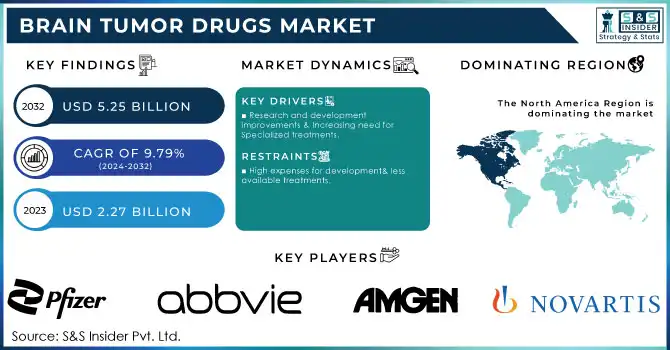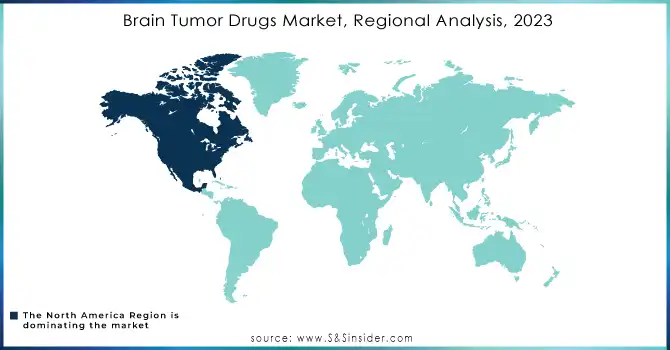Brain Tumor Drugs Market Report Scope & Overview:

To Get More Information on Brain Tumor Drugs Market - Request Sample Report
The Brain Tumor Drugs Market size was estimated at USD 2.27 billion in 2023 and is expected to reach USD 5.25 billion by 2032 at a CAGR of 9.79% during the forecast period of 2024-2032. This report provides a review of trends in brain tumor incidence and mortality rates, and how these contribute to an increasing demand for effective treatment options. The report has also discussed drug approval trends and pipeline development, which points out promising new therapies that shape the future of brain tumor treatment. It also looks into the expenditure on brain tumor treatment by different sources, such as healthcare institutions, government funding, and private insurance. The study also explores how changing consumer preferences for targeted therapies and emerging treatment solutions affect market dynamics.
Market Dynamics:
Drivers
-
Technological advancements in diagnostics, drug delivery, and research investments are driving growth in the brain tumor drug market.
Advances in imaging diagnostics, including MRI and CT scans, have also meant earlier diagnosis and accuracy in the diagnosis of brain tumors, which further leads to a better treatment outcome using targeted therapy. Developments in drug delivery systems, for example, nanoparticles and other advanced techniques to deliver drugs to the tumor site, ensure that drugs are metabolized at sites appropriately. Another major impetus is the rising global incidence of brain tumors, particularly with aging populations. Governments and private organizations are spending heavily on research, which accelerates the discovery of new therapies. All these factors, combined with an increased focus on personalized medicine, are driving the growth of the market.
Restraints
-
Factors such as the blood-brain barrier, tumor heterogeneity, drug resistance, and high treatment costs hinder the market growth
A significant challenge is the blood-brain barrier, which does not allow many drugs to penetrate tumor sites. In addition, the heterogeneity of brain tumors, with each tumor acting differently, poses a problem for universal treatment approaches. Another issue is drug resistance, where the tumor evolves and becomes less responsive to therapy. Further, the high cost of developing, manufacturing, and administering brain tumor drugs limits accessibility, especially in regions with fewer healthcare resources, making it difficult for many patients to access potentially life-saving treatments.
Opportunities
-
Advancements in Precision Medicine, Targeted Therapies, and Immunotherapy are the major opportunities in the brain tumor drugs market
The brain tumor drug market is full of potential innovation and expansion. Precision medicine offers a promising treatment for each individual with his unique genetic makeup that promises more effectiveness. Targeted therapies hold great promise in various kinds of brain tumors with very minimal side effects compared to more common side effects of general chemotherapy and radiation. Immunotherapy, including the use of immune checkpoint inhibitors and CAR-T cell therapy, is becoming an exciting option for patients with advanced or aggressive brain tumors. The collaboration between biotech companies, pharmaceutical firms, and academic institutions provides the foundation for breakthrough research, driving the development of new treatment options. Another way is increasing healthcare access in emerging markets and also expanding the access of these new innovative treatments to a larger number of patients in such markets.
Challenges
-
The brain tumor drug market faces challenges including the high cost of treatment, tumor complexity, and insufficient research funding.
The lengthy approval process for newly discovered brain tumor drugs creates major delays in treatment for patients in the hope of a life-saving medicine. Besides this, inherent characteristics of the tumors pose multiple problems, among them the tumor's resistance to specific therapies, as well as their inaccessibility due to the location inside the brain. These problems are compounded by the limited funding of research, particularly for rare brain tumor types. This makes the development of novel and more effective treatments difficult to achieve. Further, the absence of universally accepted treatment protocols means that physicians must often rely on trial-and-error methods, with suboptimal outcomes for the patient. Such factors together contribute to major impediments in developing better options for the treatment of brain tumors and improving patient care.
Segment Analysis:
By Therapy
Chemotherapy dominated the market share in the brain tumor drugs with a 36.4 % share of market in 2023 and is considered effective in various types of brain tumors. Chemotherapy targets fast-dividing cells, which characterize cancerous growth, and it has been at the core of cancer treatment for decades. Its wide availability, established protocols, and high clinical experience make its treatment of brain tumors the most dominant treatment. Chemotherapy is most effective for sensitive tumor types that respond well to systemic treatment. It poses side effects, and its efficacy is limited in some tumor types.
The immunotherapy segment is likely to gain momentum during the forecast period. This shift is mainly prompted by advances in the knowledge of the immune system and how to harness it against brain tumors. The increasing appreciation for immunotherapies such as immune checkpoint inhibitors, CAR-T cell therapies, and monoclonal antibodies can specifically target brain tumors, causing less harm than chemotherapy, the most commonly used traditional therapy. Another aspect driving the need for immunotherapy is the increase in precision medicine that tailors treatment to a particular patient according to their genetic makeup.
By Indication
The glioma segment accounted for the highest share of 38.9% in the brain tumor drug market in 2023, as it is more common and hard to treat. Gliomas are one of the most aggressive and common forms of brain tumors, and their complex biology is a significant challenge in treating them. This high demand for efficient therapies has spurred extensive research in targeted therapies, immunotherapy, and chemotherapy. Glioma encompasses the following tumor types, including glioblastomas, which are known to be particularly challenging and with a very poor prognosis, even with aggressive treatment. As such, more emphasis has been placed on novel therapies that improve patient outcomes. The large patient population suffering from gliomas remains a significant market driver.
The meningioma segment is expected to have a substantial compound annual growth rate (CAGR) over the forecast period. Meningiomas are generally benign, slowly growing tumors originating from the meninges, which cover the brain and spinal cord. Because of their benign nature, meningiomas are often more treatable than gliomas, creating a larger patient pool for therapeutic intervention. These tumors are more frequently diagnosed due to advancements in imaging techniques, leading to increased treatment demand. The growth in this segment is because of the increasing knowledge of the treatment options for meningiomas, such as surgical resection, radiation therapy, and targeted drug therapies.
By Distribution Channel
In 2023, hospital pharmacy segment was capturing a 63.2% share of brain tumor drugs market. Hospital pharmacies have the right kind of infrastructure and expertise to administer the complex treatment process, often consisting of chemotherapy and immunotherapy or other advanced drugs. Hospitals also offer integrated care such as surgery and radiation therapy that are an integral part of holistic brain tumor treatment plans.
Retail and online pharmacies are expected to grow significantly over the forecast period. The growing demand for home care by patients and the telemedicine phenomenon also increase growth as it helps patients receive prescriptions through these methods. Patients have a higher chance of visiting retail or online pharmacies since these entities provide easier access to drugs for them, besides giving them an affordable option. With this shift in preference toward more accessible and affordable options, especially for maintenance therapies that are more routine or for less aggressive tumor types, this segment will expand.
Regional Analysis:
North America dominated the brain tumor drug market with a 44.1% share in 2023 due to robust healthcare infrastructure, high research and development investment, and a high rate of brain tumor diagnosis. In particular, the U.S. is leading the pack in the availability of advanced treatment options such as targeted therapies, chemotherapy, and immunotherapy. This region is further supported by high government funding for cancer research and the presence of key pharmaceutical players, thus increasing the availability and development of innovative therapies. Patients in North America also have more access to clinical trials, further driving market growth.
On the other hand, the Asia Pacific region is likely to see the fastest growth in the forecast period. The reasons for this include increased accessibility to healthcare services, increased awareness about brain tumor treatments, and an improvement in the healthcare infrastructure in countries like China, Japan, and India. The rise in the prevalence of brain tumors due to reasons such as demographic and lifestyle factors has led to the demand for better treatment alternatives. Medical technology and pharmaceutical advancements also are coming up in the region, and they are creating innovative therapies. There is also an extension of healthcare coverage and the effort of governments toward improving the reach of cancer drugs, so the Asia-Pacific market is seen to have promising growth and this is the hub for future investments.

Do You Need any Customization Research on Brain Tumor Drugs Market - Enquire Now
Key Players and Products Offering by Them Related to Brain Tumor Drugs:
-
F. Hoffmann-La Roche Ltd – Avastin (Bevacizumab)
-
Novartis AG – Kymriah (Tisagenlecleucel)
-
Merck & Co. Inc. – Keytruda (Pembrolizumab)
-
Pfizer Inc. – Ibrance (Palbociclib)
-
Amneal Pharmaceuticals LLC – Temozolomide
-
Amgen Inc. – AMG 595 (Investigational)
-
NextSource Pharmaceuticals, LLC – Gleostine (Lomustine)
-
Emcure Pharmaceuticals – Temozolomide
-
AstraZeneca plc – Selumetinib
-
Johnson & Johnson Inc. – JNJ-64619178 (Investigational)
-
Y-mAbs Therapeutics, Inc. – Omburtamab
-
Shimadzu Corporation – Research & Diagnostic Solutions
-
Bristol-Myers Squibb – Opdivo (Nivolumab)
-
Bayer AG – Stivarga (Regorafenib)
-
Dr. Reddy's Laboratories Ltd – Temozolomide
Recent Developments:
In July 2024, The FDA approved vorasidenib for treating IDH-mutant low-grade glioma, a breakthrough based on a genetic discovery at the Johns Hopkins Kimmel Cancer Center. This targeted therapy inhibits the mutated IDH gene, slowing tumor growth and advancing brain cancer treatment.
In May 2024, Tovorafenib received approval for select pediatric patients with low-grade glioma, marking a significant advancement in targeted brain tumor treatments. This approval enhances treatment options and improves outcomes for children with this condition.
| Report Attributes | Details |
|---|---|
|
Market Size in 2023 |
USD 2.27 Billion |
|
Market Size by 2032 |
USD 5.25 Billion |
|
CAGR |
CAGR of 9.79 % From 2024 to 2032 |
|
Base Year |
2023 |
|
Forecast Period |
2024-2032 |
|
Historical Data |
2020-2022 |
|
Report Scope & Coverage |
Market Size, Segments Analysis, Competitive Landscape, Regional Analysis, DROC & SWOT Analysis, Forecast Outlook |
|
Key Segments |
• By Therapy [Targeted Therapy, Chemotherapy, Immunotherapy, Others] |
|
Regional Analysis/Coverage |
North America (US, Canada, Mexico), Europe (Eastern Europe [Poland, Romania, Hungary, Turkey, Rest of Eastern Europe] Western Europe] Germany, France, UK, Italy, Spain, Netherlands, Switzerland, Austria, Rest of Western Europe]), Asia Pacific (China, India, Japan, South Korea, Vietnam, Singapore, Australia, Rest of Asia Pacific), Middle East & Africa (Middle East [UAE, Egypt, Saudi Arabia, Qatar, Rest of Middle East], Africa [Nigeria, South Africa, Rest of Africa], Latin America (Brazil, Argentina, Colombia, Rest of Latin America) |
|
Company Profiles |
F. Hoffmann-La Roche Ltd, Novartis AG, Merck & Co. Inc., Pfizer Inc., Amneal Pharmaceuticals LLC, Amgen Inc., NextSource Pharmaceuticals, LLC, Emcure Pharmaceuticals, AstraZeneca plc, Johnson & Johnson Inc., Y-mAbs Therapeutics, Inc., Shimadzu Corporation, Bristol-Myers Squibb, Bayer AG, Dr. Reddy's Laboratories Ltd. |

